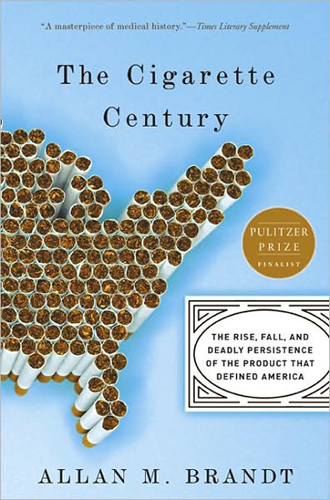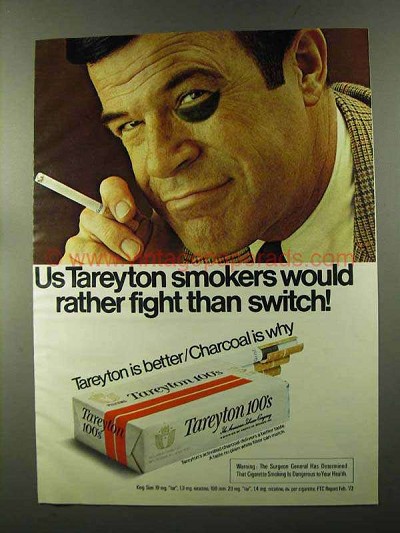Reading The Cigarette Century: Reflections on the Cultural Impact of Smoking from 1900 to 1970

When the 20th Century Went Up in Smoke
The Cigarette Century: The Rise, Fall, and Deadly Persistence of the Product that Defined America by Alan Brandt is not a boring treatise on the history of tobacco. There are more than a few of those books in print, and they are entirely forgettable. Brandt's rise to a different level because it genuinely does tap into the real reason why cigarettes were so enormously popular in the 20th century. The cigarette played a significant role in creating cultural identity throughout the 20th century.
The Cigarette as a Cultural Icon Defining a Century
Rising to the level of a cultural icon that helps shapes several generations is no small task. The achievement is even more profound since it came from an inanimate object that can cause premature death.
Culture is never, ever static. What may have been wildly culturally relevant at one time can find itself being, at best, hopelessly dated. At worst, a cultural movement can be looked back at as a disdainfully gross mistake. The Cigarette Century (a.k.a. The 20th Century) can fall into both categories.
The cigarette's modern image is that of a useless and harmful vice partaken by a small number of the population willing to take severe risks with their health. That is a far cry from what existed as far back as only 35 years ago when smoking still maintained a level of cultural relevance that appealed to roughly half the United States population.
How have our perceptions of cigarettes changed over the years? Consider this: the modern understanding of an executive at a cigarette company is hardly a positive one. The contemporary incarnation of a cigarette executive is deemed little more than a greedy corporatist skirting on society's margins, boosting revenues from a practice that serves no public good. Millions of people hold such a professional in utter contempt.
It did not always use to be that way.
How did the public perceive a cigarette executive in the 1950s? The closest comparison we can make is the cigarette executive of the 1940s and 1950s was held in the same regard as modern audiences view the big names and major movers and shakers running the top social media sites. Yes, cigarette executives were culturally iconic business professionals who reached celebrity status.
They held much of the culture at their fingertips.
Yes, times, along with the culture, do change.
The Cigarette Century is not so much a book about smoking any more than an actual cigarette is really about smoking. Cigarettes are not about smoking; they are about marketing. They are not solely about marketing the actual product, though. They are about selling an identity.
They also open a gateway into revelations about human nature and American culture in the early 20th century.
The Cigarette Through a Historical Lens
Through the lens of history, people do not look at the cigarette from all its different complexities. Truthfully, they do not look at it through the lens of history at all. Look at the perceptions about cigarettes and the tobacco industry from an image that evolved over the past 20 years. As most people see things, cigarettes were popular for several reasons. People did not know there was anything in cigarettes that could harm their health, so they saw no reason not to smoke. Costly and, honestly, innovative advertising campaigns lured in customers. As people learned cigarettes could cause major, adverse health problems, smokers began to quit. Those who tried to quit after developing a lifelong habit had a tough time doing so. The addictive nature of the nicotine-laced cigarette made kicking the habit (addiction, actually) difficult.
Today, more people are aware of the problems with smoking and never start. Changing attitudes about smoking have lead to a significantly limited interest in cigarettes. The dramatic decline in cigarette advertising also makes it hard to draw in customers. Just look at the "safer" alternative e-cigarettes. While popular with some consumers, e-cigs are not growing out of their niche.
For the most part, these assessments are accurate, but they are also a gross simplification of the role cigarettes maintained in our society.
Cigarettes and Their Role in Culture and History
The mantra to realize here is cigarettes are always more than just cigarettes. In the 20th century, a pack of cigarettes held a much more culturally significant role than the mere bad habit they reflect today.
Cigarettes reflected various sentiments ranging from freedom, individuality, a passage into adulthood, and a rejection of rules. Cigarettes were interlocked with marketing and the art and science of branding. Brandt so aptly points out that billions of billions of dollars were earned selling a product that literally offers nothing of use. Yet, the smoking public did see the enormous benefit of being a smoker. These perceived benefits were focused upon heavily in the advertising campaigns heralded by the brands.
Modern audiences cannot look at the cigarette in the same way it was presented from 1914 to 1970. The cigarette's contemporary image is that of the perennial horrible habit and social practice that will not go away. Again, these are superficial assessments of The Cigarette Century.
Superficial is the norm for what people think they know of history, a commonly ruefully overlooked area of study. History is only learned superficially and glossed over in most formal educational settings. Those who are scholars expand their research when furthering their education. This furthering can be done by continuing into a Master's program or merely watching a lot of documentary programming on The Discovery Channel. Even those scholars only commonly delve into the areas of study that interest them the most.
Not everyone is privy to what happened in years previously. They not only did not study what occurred; they did not live through it. History becomes lost, and so with it, we lose the present and the future. The reason we study history is many folds. Looking at the past shows us what tends to work well and what has a tendency to fail. We also learn about the lineage of our cultural development. Once we cease to look at history closely, our present becomes little more than something we found ourselves cast into. Looking at cigarettes through the eyes of history allows for a greater understanding of the complexities of human nature and the consumer culture, two items never lost to history.
Neither is man's search for meaning and his place in the world.

The Cigarette: More Than Just Rolled Paper and a Filter
Western civilization draws much from the discovery of the individual. This notion dates back to Beowulf and is present through literature in many forms and found its way into various popular culture works. An error in thinking occurs when we believe the individual's discovery is based solely on works of fiction and only influences real life. Self-discovery and self-actualization are critical facets of life worth living. Every person tries to find their place in the world in some way.
Self-discovery does not exist in an existentialist vacuum. Well, it can, but not very many people strive for the life of a loner. People do want to be accepted, and they want to live for acceptance into a social group. The history of cigarette smoking strangely reflects a desire to join a group. Although many less than intellectual treatises on smoking make the case smokers are antisocial delinquents, the truth is smoking demonstrates the journey of the self into adulthood. In the early part of the 20th century, smoking cigarettes was critically crucial for upwards of 40+% of the population. Smoking reflected the transition from being a child to an adult. For men, they would enter into the masculine world of the Marlboro Man. For women, there was an entry into the sophisticated high society of Virginia Slims.
All of these images were consistently promoted via the media and the entertainment industry. The image of James Bond smoking in Goldfinger surely affected the millions of people who were caught up in Bond mania. Anyone watching reruns on GSN (Game Show Network) can watch hosts puff away on their gaudy 1970s set.
The vast majority of the millions of people who embraced cigarette smoking during its culturally significant points during the 20th century did not intellectualize such things as the discovery of the individual, acceptance by a group, or the influence of pop culture. They subliminally absorbed all these influences and, not so subliminally, found themselves attracted by powerful advertising and cultural influences.
Cigarette Smoking as a Cultural Identification
Was cigarette smoking truly that important for a person's identity? At the initial self-perception of transitioning to an adult, it could be. Of course, millions of others transitioned into adulthood without ever smoking. And the truth is, several decades and thousands of cigarettes, all the cultural and sociological aspects are long forgotten and no longer relevant. All that feeds the use of cigarettes is nicotine addiction.
Brandt quotes an unnamed advertising executive who pointed out the decision to smoke involved a lot more than just smoking. It was a rite of passage into a new identity.
''We're not selling a pack of cigarettes, we're selling a way of life.''
Once you purchase a particular cigarette brand, you are purchasing entry into the exclusive club the cigarette company reflects in its advertising campaigns. Those campaigns have certainly become muted over the past 30 years. The advertising campaigns that have been relegated to forgotten history are quite revealing when their time capsule is opened.
An old Marlboro Country commercial shows several cowboys out in the wild sharing a smoke. There is a sense of camaraderie among the men. Such bonding was not limited to Marlboro Country. Cigarettes were often smoked in lounges, bars, coffee breaks, and other social gatherings as a communal event. This particular Marlboro commercial shares that same sentiment while promoting the individual spirit that Marlboro Country and the Marlboro Man represented. As Brandt points out, the Marlboro Man was also about simplicity and a simpler time, free of worries and anxieties. Partaking in a Marlboro was a celebration of a time before the world became too complicated. This imagery, combined with the rugged appeal to men, helped make Marlboro enormously successful. Virginia Slims borrowed a page from Marlboro Country's book by created cigarettes designed to reflect a liberated and sophisticated woman.
If cigarettes were just about selling tobacco, they would never have sold more than minimally, addictive or not. To become addicted to nicotine, someone has to start smoking. There must be a compelling reason to start and to follow up with a regular habit. The taste of tobacco is not enough. A grand marketing scheme that taps into cultural sentiments is required. This is exactly what the tobacco companies of years past were able to deliver.
No One Loves a Liar: The Slow and Agonizing Death of the Cigarette (Almost)
20+% of Americans still smoke. 50 years ago, the number was 42%. More so, as far back as 30 years ago, you could smoke anywhere you wanted. In the late 1970s, fast food restaurants commonly had nonsmoking sections that were 1/5th the smoking section's size.
There are a few reasons for the decline of the cigarette. The more people know about the dangers of smoking, the less likely they are to smoke. Increased awareness of the risks makes coming up with advertising campaigns a lot harder. Cigarettes can no longer promote a manufactured image when all the health hazards associated with their use are known.
Most stinging, the late 1990s saw the release of documents showing tobacco executives lied about their knowledge of health hazards and addictive properties. Public sentiment was massively negative, and the industry lost much of its political power. The long knives came out for the industry, and it exists as a shell of what it once was.
That shell is a current number of about 45 million customers.








